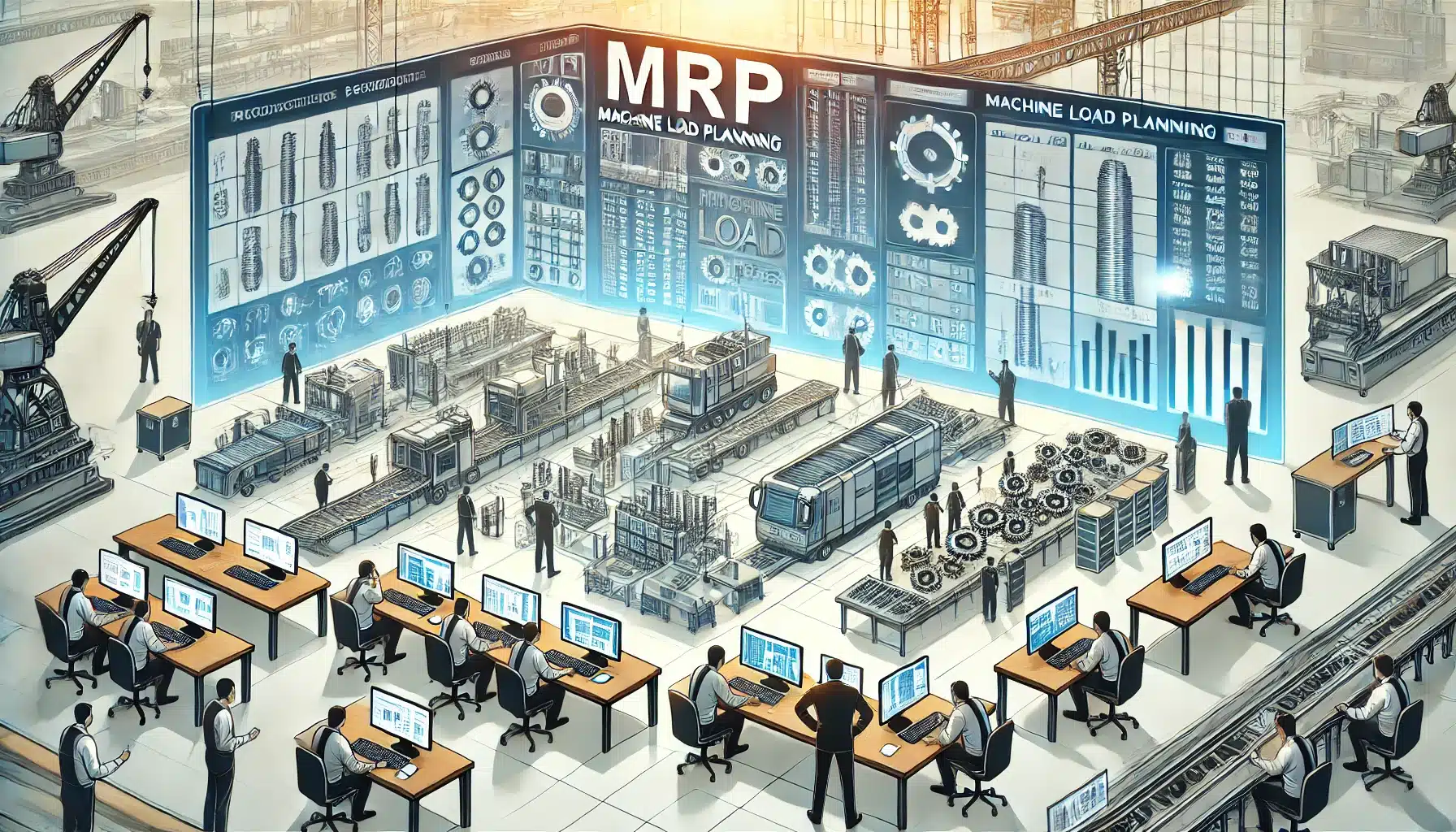Description
Material Requirements Planning (MRP) is a critical process in the management of industrial operations. It helps optimize resource utilization and ensure on-time delivery of finished products. Two main approaches stand out in this field: finite capacity planning and infinite capacity planning. This article explores both methods, their advantages and disadvantages, and proposes a combined strategy for efficient production management.
1 solution: do both in sequence!
- Step 1 -> Infinite planning: Start by doing your infinite capacity planning, editing production lists with short-term scheduling. This first step aligns strategic priorities and gives a clear direction to the shop floor by editing production lists with short-term scheduling. This initial method provides an overview of production requirements without worrying about capacity constraints, ensuring that all important orders are taken into account. It defines an initial production plan that serves as the basis for organizing operations, ensuring that the company’s strategic priorities are met from the outset.
- Step 2 -> Finite planning: Next, carry out infinite planning to manage bottlenecks, spread the delay bubble, identify service rate problems, and manage capacity load matching.
Once infinite planning is in place, the transition to finite capacity planning is necessary to refine this initial plan. This step enables us to effectively manage bottlenecks, spread the delay bubble and identify service rate problems. By taking actual capacity into account, this method adjusts previously defined priorities and deadlines, ensuring an optimum match between workload and available capacity. It also resolves operational problems that may arise, optimizing resource utilization and minimizing the risk of overloads and delays. By combining these two approaches, companies can benefit from flexible and realistic production management, capable of adapting to changing market requirements while optimizing the use of available resources. This sequential strategy ensures practical and efficient implementation of production plans, guaranteeing customer satisfaction and on-time delivery.
Material Requirements Planning (MRP) is an essential process for optimizing resources and ensuring on-time delivery of finished products. To achieve efficient production management, a combined strategy of the two main planning approaches, infinite capacity and finite capacity, is recommended. It’s crucial to start with infinite capacity planning to align strategic priorities and establish production lists with short-term scheduling, offering an overview of requirements without capacity constraints. Then, by switching to finite-capacity planning, it is possible to manage bottlenecks, spread out delays, identify service rate problems and guarantee the match between load and capacity. This sequential approach leverages the advantages of each method: initial flexibility to define priorities, and realistic capacity adjustment to optimize execution. By combining these two steps, companies can ensure smooth production, meet market requirements and maximize the efficiency of available resources.
1. Resource optimization
Bottleneck management: Finite capacity planning is distinguished by its ability to identify and manage bottlenecks in the production process. Infinite planning, on the other hand, takes no account of capacity limitations, which can lead to work overloads.
Resource reallocation: The flexibility of infinite planning means that resources can be quickly reallocated to meet changing priorities, whereas finite planning requires more rigorous, structured management of available resources.
Step 1: Infinite planning
The first step is to use infinite planning to establish a production list without worrying about capacity limitations. This approach aligns strategic priorities and ensures that all important orders are taken into account. Shops thus receive clear lists of products to be manufactured, facilitating the initial start-up of production and ensuring that essential needs are covered.
Step 2: Finished planning
It’s essential to start with infinite planning to align global priorities and define the production lists to be passed on to the workshops. This initial approach provides a clear view of production requirements without capacity constraints. Then, by moving to finite capacity planning, bottlenecks can be effectively managed and available resources adjusted to optimize production processes. This allows real limitations to be dealt with and ensures a smoother workflow, while minimizing the risk of overloads and delays.
2. Workload balancing
Capacity planning: infinite planning starts with a global assessment of production requirements, regardless of available capacity. This approach aligns priorities and defines an initial production list. Then, the transition to finite capacity planning enables workload to be distributed fairly according to actual capacity.
Balancing workloads on machines and workers: Finite-capacity planning adjusts workloads on machines and workers, thus avoiding overloads and under-utilization. Infinite planning, on the other hand, provides an initial vision without these adjustments, requiring a second stage of refinement.
3. Order prioritization
Task scheduling: Infinite scheduling facilitates the initial scheduling of tasks according to strategic priorities. Once priorities have been defined, finite capacity planning adjusts this scheduling to meet capacity constraints.
Managing production priorities: In an infinite-capacity approach, production priorities are defined regardless of physical limitations. This method gives workshops a clear direction. Finite-capacity planning then refines these priorities according to operational constraints.
Step 1: Infinite planning
Infinite planning facilitates the initial scheduling of tasks according to strategic priorities, regardless of physical limitations. This method gives a clear direction to the shop floor and ensures that all important orders are taken into account. By establishing an initial production list, this approach provides an overview of priorities, making it easier to get operations up and running.
Step 2: Finished planning
Next, the transition to finite-capacity scheduling enables the scheduling to be adjusted to meet capacity constraints. This step refines the priorities initially defined, and takes into account the actual capacities of available resources. By integrating capacity constraints, this method enables tasks to be efficiently managed according to operational resources, optimizing task scheduling and ensuring smoother, more realistic production.
4. Time and delivery management
On-time delivery: Infinite planning helps to establish ideal delivery times by aligning production priorities. Finite-capacity planning adjusts these lead times to actual capacities, helping to manage potential delays and optimize deliveries.
Synchronization of production flows: Infinite capacity planning ensures a global and coherent view of production requirements. By integrating actual capacities in a second step, finite capacity planning enables production flows to be synchronized realistically and efficiently.
Step 1: Infinite planning
Infinite planning helps to establish ideal delivery times by aligning production priorities irrespective of available capacity. This approach makes it possible to define an initial estimate of delivery dates based solely on strategic needs and priorities. By providing clear direction to the shop floor, this method ensures that all important orders are initially considered and planned.
Step 2: Finished planning
Next, the transition to finite-capacity planning allows these lead times to be adjusted in line with actual capacities, enabling potential delays to be managed and deliveries optimized. By integrating actual capacities, this method synchronizes production flows realistically and efficiently. It adjusts the priorities defined during infinite planning to guarantee optimal use of available resources and ensure delivery commitments are met, even in the event of operational constraints.
5. Simulation and scenarios
Analysis of production scenarios: infinite planning provides a framework for analyzing different production scenarios without being limited by capacity constraints. Once these scenarios have been established, finite capacity planning can be used to assess their feasibility and identify any necessary adjustments.
Impact of capacity changes on production: The flexibility of infinite capacity planning makes it possible to simulate the impact of capacity changes on production. Finite capacity planning, on the other hand, validates these simulations by taking into account actual operational constraints.
Step 1: Infinite planning
Infinite planning provides a framework for analyzing different production scenarios without being limited by capacity constraints. This approach makes it possible to explore various strategic options and anticipate production needs in line with corporate priorities and objectives. By simulating various scenarios, this method provides an overview of possible production paths, facilitating initial decision-making.
Step 2: Finite planning
Next, the transition to finite capacity planning enables the feasibility of the established scenarios to be assessed, and any necessary adjustments identified. By taking into account actual operational constraints, this method validates the simulations made during infinite planning. It adjusts scenarios according to available capacities, ensuring that production plans are feasible and optimized for efficient resource utilization. This allows production strategies to be adapted to the realities on the ground, ensuring practical and efficient implementation.
Why do MRP first finite, then infinite?
MRP planning, whether in finite or infinite capacity, offers distinct advantages. Starting with infinite capacity planning enables you to align priorities and define an initial production list. This approach gives a clear view of production requirements, without being limited by actual capacities. Moving on to finite capacity planning enables bottlenecks to be managed effectively, delivery times to be adjusted in the event of problems, and resources to be used optimally.
By combining these two approaches, companies can benefit from flexible and realistic production management, capable of adapting to changing market requirements while optimizing the use of available resources.




